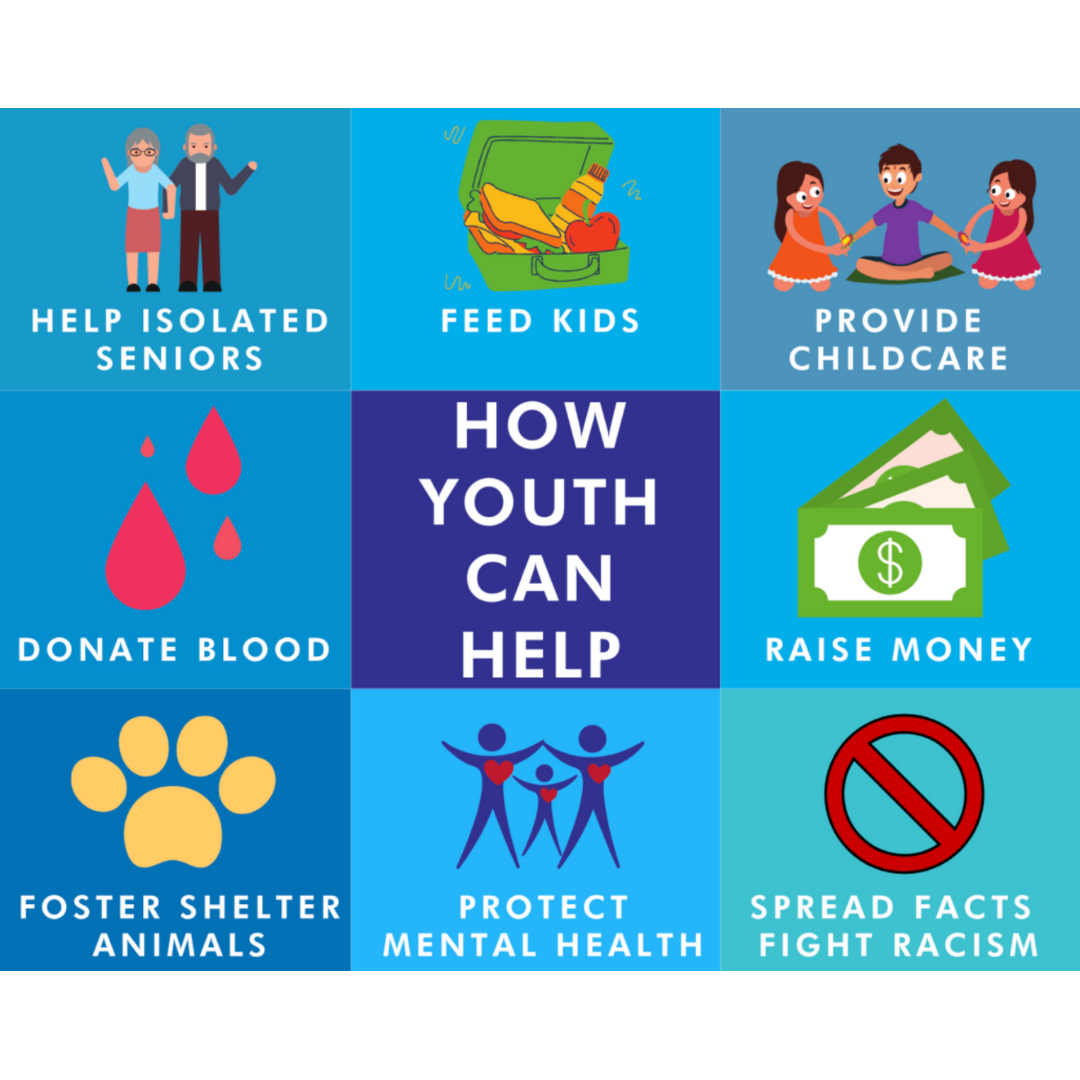10 Ways You Can Help Your Community During COVID-19

Volunteering and service are more important during a crisis than ever. Social distancing does not mean social isolation. We’re all in this together, so be a helper. Let’s all do our part to contribute to the common good, so that when this crisis is over, we’re proud of how we came together to keep our young people, our communities, and our democracies thriving.
Here are 10 ideas for how you can help your community respond to the coronavirus crisis.
1. Help seniors or others who are isolated – check in with them to see what they need; then run errands, deliver food and medication, pick up library materials (if your libraries are still open), etc. Make regular phone or video call visits to combat social isolation/loneliness. Make cards or write letters, emails, or social media messages to seniors in nursing homes who can’t have visitors.
2. Help provide access to meals for students who rely on school meals. Many states and school districts are providing “grab and go” meal pick-up locations, and you can help by spreading the word and helping kids get to sites if they’re not within walking distance. Donate to your local food banks. When donating, consider starting with your wallet instead of your pantry. Donating money gives food banks flexibility to buy exactly what they need when they need it. Work with local entrepreneurs to turn closed restaurants into community kitchens, following the lead of Jose Andres.
3. Older teens and college students can provide childcare for family/friends/neighbors if schools are closed, but parents still have to work. Organize a neighborhood childcare co-op to share the responsibility. There are a ton of resources including these 101+ ideas, virtual field trips, and lessons from Scholastic’s Learn from Home website,
For ideas 1, 2, and 3, adapt this guide that shows how to create a “neighborhood pod,” a DIY task force for organizing a community. The Google doc shows how to create a contact sheet, a group chat, and a list of questions around how to help each other during crises like the coronavirus. You can also connect via neighborhood email list-servs, Facebook groups, or Nextdoor.
4. Raise money for relief organizations or local nonprofits. Help spread the word to crowdfund these coronavirus relief funds from Center for Disaster Philanthropy’s COVID-19 Response Fund, GoFundMe, GlobalGiving, and Global Impact to help provide needed medical supplies, public health support, and more. Research online to find local fundraisers to help people in your community or support any local nonprofit that has increased needs to meet because of this crisis. Fundraising can be a fun activity to spend time doing while schools are closed. Make cards, artwork, jewelry, or other handcrafted items to sell virtually. Organize virtual “thons” (walk, skate, bowl, swim, bike, rock, read, dance) of an activity that people can do and track individually. Anython and RallyUpare two online tools that can help you organize these.
5. Donate blood. As the number of individuals with coronavirus increases, fewer eligible donors will be able to give making it extremely difficult for inventory to recover if we get to shortage levels. Healthy, eligible individuals are encouraged to schedule a blood or platelet donation appointment at RedCrossBlood.org today to help maintain a sufficient blood supply and avoid any potential shortages.
6. Foster shelter animals. Many shelters have already had to close to the public or cancel events, and many others may need to do so in the coming days ― meaning fewer pets are being adopted out, even as animals continue to come in. Shelters want to move as many animals as possible off the premises and into foster homes, in case they’re hit with staffing shortages as employees and volunteers get sick or need to self-quarantine. Find a shelter or rescue organization near you.
7. Protect the mental health of your family, friends, and neighbors. Check out these resources from the Born This Way Foundation and de-stress by reading stories on Channel Kindness. For those experiencing mental health challenges during this time, there are resources like the Disaster Distress Helpline. Take a break from the news and go outside, play a game, watch your favorite tv show or a movie, etc. To support others who are having a hard time right now, one expert says that just dismissing their worries can be counterproductive. “If I tell you, don’t worry about it, everything’s fine, that really discounts my concerns.” Instead, “with our friends and families that are feeling distressed, we can empathize and we can validate that this can be a really scary, anxiety-provoking time.” Rather than telling someone not to worry, consider asking what they are doing for self-care. And stay in touch if you can, “because when we sit with our thoughts all by ourselves, they can spiral.”
8. Spread facts and promote the behaviors individuals should be doing to stop the spread of the virus. Scholastic has resources to teach about the coronavirus for grades preK-3, 4-5, and 6-12. Stop misinformation by always using official sources like the CDC, WHO, or your state or local government. Read this guide on spotting coronavirus misinformation, and direct your friends and family to WHO’s EPI-WIN project for mythbusters, advice, and info about the coronavirus.
9. Fight xenophobia and racism around the origin/spread of the virus. Jason Oliver Chang, an associate professor of history and Asian American studies at the University of Connecticut, started a crowdsourced document with resources for fighting racism around coronavirus. The document notes that many are using the hashtag #IAmNotAVirus to share anti-racist messages during the outbreak. Learn how to have conversations about the racism and xenophobia that coronavirus brings up.
10. Advocate at the local level for relief & support for vulnerable populations and those affected by the economic disruptions (people out of work or not being paid because of closures caused by the virus). Use our collection of advocacy tools to get started.
